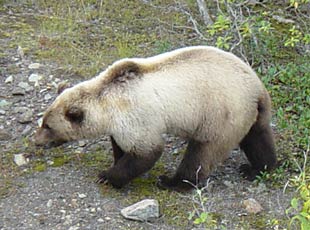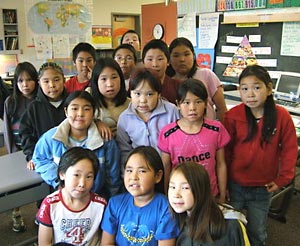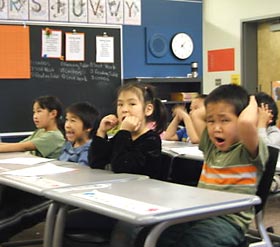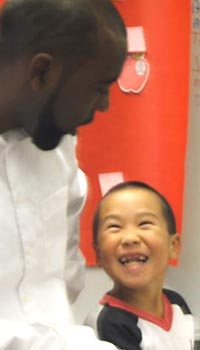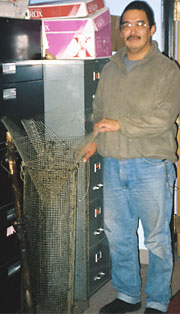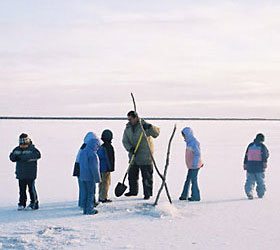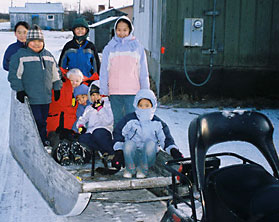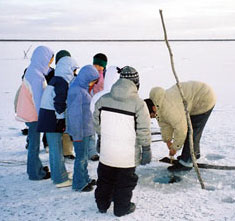Historical Mentor Stories
Four hours later, I got the call to go to the airstrip. I got there ready to fly, watching as the first plane comes and leaves. It's a charter and I’m on a seat fare. So I am taken back to my teacher’s house. She was inside baking cookies, but didn’t answer the door because she didn’t hear me knocking. Luckily it was not freezing outside! So the school custodian returned to take me back to the airstrip, and reassures me this is the plane. The second plane arrived and was quite big, but not going to my destination, so they left me behind. I decided to sit at the airstrip because the truck was full of volleyball players who just arrived and needed to be transported to the school.
After about 20 minutes, the third plane arrived. I politely asked if it’s going to my destination, and the pilot responds, "Yes." He put my luggage on the plane and we were off. We arrived at the correct airport in about 15 minutes . It was a great take off, flight, and landing. So I had to ask this very young gentleman how old he was, and he replied "20"—definitely my youngest pilot ever, but a very talented one.
I've realized in a concrete way the critical role elementary teachers play in the success of learning that will take place as the students move into secondary education. Through this learning, I have developed a very deep sense of respect for the work elementary teachers do, which I didn't always have in the past. In addition, I cannot believe how much I am learning about my own practice—the "why" some things were working and other's weren't. Even more, I'm learning how I can become a better teacher by implementing strategies used at the elementary level: to teach across the curriculum through one main content area; to teach students with their basic needs fulfilled first; to prevent rather than react to problems; and to ALWAYS have clear focus/learning goal for class time (I did this before, but until now, hadn't realized how much impact that truly has on student learning.)
About the mentor project's impact on a early career teacher:
Just the other day a early career teacher thanked me for "forcing" her to reflect on her practices and self-assess using the Professional Teaching Standards Continuum. This reflection did for her, in a way, what the program has done for me. She saw good things that she was doing "by accident" and those strategies became more concrete. She also saw areas of struggle in which the solutions were within reach. Overall, the reflection—the looking back—has inspired her to more forward.
A second-year teacher was so excited last when we visited. She said, "My kids are so much further along this year than they were this time last year. I know from the tools we used last year and are using this year that I can do more with them and that its not only okay but I must expect more from them. Last year I was afraid of pushing too hard-and while I'm careful to pay attention to the assessments-I know I have to have higher expectations. I don't think I would have made these gains without your support."
The Grizzly Mentor — By Pat McDonald
I am meeting with an early career teacher who is weathered and athletic looking—an
avid sportsman living on game meat and adrenaline. He told me he would meet with me,
but had already planned to go fishing, so I asked if I could come along. "Sure," he
said. "We'll walk out. It's only about a mile to my good fishing hole". "Arctic char,"
he said. "For class tomorrow," he added.
The day was beautiful, sun shining down and the ground spread out like a carpet of green with berries for texture. The seemingly level ground was deceptive. The arctic tundra was covered with hillocks and trenches of mud and the rutted 4 wheeler trail was a quagmire. We picked our way along, the dog trotting ahead and doubling back to catch up. We chatted it up, discussing possible field trips, me being flexible and living with ambiguity. Developing a relationship was important to mentoring, I'd been told.
|
|
We reached the crest of the moraine, the creek rippling along in both directions about 100 yards away. Then it moved. The enormous grizzly bear stood up on his hind legs and looked right at me. He seemed to be saying to me, "Can you really count this as a mentoring experience?"
To my credit, I didn't wet my pants. I just calmly remarked, "There's an enormous grizzly right by your fishing hole," or something else that neither of us can remember now. The sportsman pulled out his pistol and waved it crazily in the air, alternating "Holy s---" with "Zatu, come back!" to the dog. The dog, although he'd seemed smart up until now ran directly at the bear, stopping short about 20 feet away. There was a lot of grasping of the head and sweaty palms, and that was just me. The sportsman was even more excited.
For the past 15 months, I have been on a journey learning how to become a mentor to novice teachers. Along the way I have picked up several nuggets of critical learning, all which will influence either my teaching if I return to the classroom or my practice if I continue working with early career teachers.
First it is absolutely essential to student success that teachers learn about the students' community, cultural values, and languages. Helping students connect learning to their lives is an essential piece of student academic achievement. We Can't Teach What We Don't Know, by Gary Howard, is one resource for explaining why this preliminary background knowledge step should be a prerequisite to teaching.
Second, I've learned that mentoring requires trusting relationships. Mentoring is a dynamic two-way journey where both mentor and teacher are learning. For growth and the development of best practice, there must be equity in voice and true collaboration. Mentor and early career teachers must always be willing to listen to each other to negotiate meaningful next steps.
The journey to effective mentoring for me has included ongoing and consistently high
quality training and support. The strong foundation provided to me by the Alaska Statewide
Mentor Project has given me the best-equipped vehicle to make this journey successful.
Together with my 24 colleagues across the state and with our 380 early career teachers,
we are making things better for Alaska's future generations.
Where to begin? Maybe with Lorrie; after all she's the one who told us when leaving
one school for another we need to be ready at the drop of a hat, so someone can find
us and get us to the airport in time to catch our flight. Right? Not exactly. She
didn't tell us the path to the airport might be washed out to the Bering Sea!
|
|
Yesterday afternoon, oh, I'd say around 2:00 PM, an all-call came over the Kotlik school intercom telling everyone that the river was rising. One of the wives had called, looking for her custodian husband so he could get home. She was worried about their boat going down river. That was the beginning. But naïve, inexperienced Jan Littlebear didn't know what that all-call signaled. I finished working with my ECTs, caught up on emails and paperwork, ate my tuna-covered Pilot bread, some dry fruit, took a shower, watched TV-the news and CSI, read some more of my book (Eats, Shoots & Leaves) and fell asleep in one of the most comfortable places a person could hope to bed down. It was warm, cozy, quiet and I only heard an occasional dog barking. Come to think of it, though, the barking dog did have an eerie, helpless timbre to its pitch. I should have known.
Just the day before, as I remained tucked in my sleeping bag on my "wonder" bed (that's another story); the lights came on in the school at 6 AM. So this morning I got up at 5:45 AM, dressed, rolled up my sleeping bag, packed my clothes, put the bed away, returned the classroom to hopefully its normal state, heated some leftover coffee (YUCK!), ate a breakfast bar, an apple, and some pears; got my paperwork ready, lined out my schedule for the day, checked my email, when all of a sudden it dawned on me it was now 7 AM and the school was still dark, the lights were not yet turned on, and there were no people around-usually teachers start arriving by 6:30 AM. Of course it was still dark outside so I couldn't see. I should have known.
|
|
Then from 7 until 8 in the morning, everything happened. People arrived, a few students showed up, and the stories began. Many of the villagers and teachers had been up at midnight, again at 1, 2, 3 and 4 in the morning (while I zzzz'd away!) working to save their belongings- anchoring boats, securing personal stuff that was floating away, making sure ATVs and other survival equipment would still be there when the light of day arrived. Teachers began their normal trek to school, walking on the usual boardwalk path that always brings them to school, only to step into knee-high water and retrace their steps to their homes to change clothes and take an alternative route. They arrived-all of them-in a timely manner. The principal announced there would be no school and for staff to come to the kitchen, along with the smattering of students present, to eat breakfast which had been prepared for the children. We all ate; it was my second breakfast.
This proved to be an absolutely terrific opportunity for me to share some quality social time with one of my ECTs. Just like I had done, this is an older ECT beginning a second career, so he and I already had much in common. A youngster sitting next to us looked at him and commented, "I never heard you laugh so much!" Perhaps he and I were being a bit too social for the moment. :) At the coffee pot in the lounge, I spoke with the day man who told me his story–he was up all night trying to get his boat back. Lucky he had a friend with a boat; probably all Kotlik villagers have such a friend, maybe next time I can even find a way to be a friend (if I'm awake, that is). "How could you search, you know, how could you see at that hour of the night?" I asked. He replied, "Well, my friend has a spotlight on his boat, and I held out my flashlight, and we just kept searching." "Did you find it?" "Yeah, it was drifting out to sea! I'm glad we found it. I need that boat." He was busy cleaning up at school, doing his usual chores and duties, working a seemingly normal day. I'm pretty sure he was operating on little, if any, sleep. Of course I was wide awake. The children who had sloshed their way to school were escorted home, one by one. About 8:30 only the staff remained. I still should have known there was more to come.
|
|
I asked if flights would happen, and was advised to wait until about 10 AM, to see where the water was, and then call. It was starting to get light out and I could see how the water had moved up towards the school and homes. It was amazing the litter, belongings, and I'm sure treasures that had been moved from one place to another in the village of 600. I met with two ECTs, we did the collaborative log, and I called the airlines. "Sure, Grant Airlines will be there, but you'll have to get your own way to the air strip because the boardwalk is washed away. You'll need to find a boat." Oh, darn, I did not pack a boat. Lorrie! Are you there? Hello! :) A boat...okay, we're resilient, I can do this. I first checked with Bernie, the secretary-cuz secretaries know everything, right? She said all the boat people (her words) had gone home. I go in search of Richard, the teacher married into the village and about to retire after 18 years working at the school. I figure he probably knows everything, too!
"Richard, have you got a boat?" "Why?" "Because Grant Airlines tells me I need one to get to the airstrip." "Come on, Jan, I can get you there on my ATV." Thus, the adventure begins!
It's blowing, raining, and getting cold. I have on tennis shoes, by the way :( I'm layered everywhere, but tennis shoes are what cover my feet. We bundle up, go outside and climb aboard his ATV - he puts my 30# duffel bag on the front, holds my briefcase, and "anchors" me behind him. That means he told me to "Hang on, Jan!" I did. It's probably a mile to the airstrip, how hard can that be? Richard and I embark, it's slow and easy going as we sail right over the tops of a lot of debris and wood and glide by personal belongings littering the teetering boardwalk. Other items float by, or are blown along by the wind. My captain is being cautious and I'm sure a lot of that caution was due to the greenhorn sailor-mentor sitting sidesaddle alongside. He reminds me to keep my feet up. I do. Along the way someone is sort of blocking the boardwalk with his ATV, it's broken down and he needs a welder. He asks, "Richard, do you have a welder up at the school?" Richard tells him no. That man and his ATV limp off the trail forward, out of our way, so that we can continue our crossing.
|
|
Another villager says, "You be careful Richard, there's a washout up there." I do wonder about this statement, but I also trust Richard. We continue. People wave from their homes, children in their front yards splash through the water wearing their rubber boots—smart kids wear rubber boots. Kotlik is no longer still or quiet. Although many of the dogs seem to be asleep atop doghouses or other places resting, there's at least one active furry guy alert and watching everything. This curious canine is staying dry, holed-up in a boat that is moored next to the steps leading into its owners' home. At one point we "slide" off the boardwalk into the water, at least one wheel slides, that is: mine - my tennis-shoe-clad foot is submerged. Rich says "Hang on, sit still." I do. He manages to get us unstuck and we proceed. I wish I had my camera handy; I can describe it for you, but I'd rather show it to you. It was an image-laden voyage, about to come to a screeching halt! (Can you "halt" a boat/ATV?")
We approach the 6-foot washed-out boardwalk, only a bit more than a city block distance from the airplane which is now watching and waiting for us. Richard, wearing boots, (they're all so smart in Kotlik) hands me my briefcase so he can disembark, check the depth of the stream, and decide whether to proceed or return. A true adventurer, Richard advises we're going on. We enter into the running current, that flooded stream which is-much like a migrating salmon-trying to connect with the Yukon and journey onto the Bering Sea. We make it for a distance-one foot, two feet, three...whoosh! We stop. You can feel the back, left wheel starting to sink, to submerge; Richard maneuvers the controls, the wheel spins; I hope...but the wheel is descending. He says, "Come on, Jan, I'll help you get to the boardwalk, it's real close." I trust Richard. My now-topsy-turvy vantage point from the far side of the ATV's seat is simply not "conducive" to even seeing, let alone "finding" the boardwalk, but I really do trust Richard! I hand him my briefcase (that damn thing will be in the duffel bag next time!), turn around and back down off my crow's nest perch. His expertise helps my soggy shoe find solid footing and from that moment on it's an easy thing to push off from the ATV and actually stand up erect (or is it "a wreck?") ready to walk the remaining little bit to the plane. Rich, my knight in shining (but wet) Carharts, carries my heavy bag; I take that NUISANCE of a briefcase. Three other passengers are ahead of me, a man about my age and an elder with his preschool-aged grandson. They all walked. The man is soaked from behind his knees to his feet - he has on Carhart bib overalls. The little boy, dressed in a green rain slicker, is as dry as cotton. Grandpa, dressed in rain gear, also appears to be pretty dry-both Gramps and Grandson are wearing rubber boots! I have two wet feet. I rethink my dress for next time. I climb onto the plane, fly into a strong headwind and arrive at Emmonak where the electricity is out. Then board another plane to Alakanuk where, as we approach the school, I can see children at recess, playing down below. And I think, "Whew, back to work." I LOVE this job.
Mentoring the Mentor — By Jan Littlebear
First year Yupiit instructor Elena, with the assistance of a local fish trapping expert
named Henry White, arranged for her middle school students to make, set and check
fish traps in the Lower Kuskokwim; and for her 3rd graders to check for fish trapped
in nets that had been sewn and set under the ice near the school; and finally for
the high schoolers to sew the nets, make their own fish traps, set them and later
check their traps for fish. All of these wonderful traditional, cultural experiences
were taking place over the course of several weeks, ending the first week of December.
Enter the mentor! I arrived the week when all three classes were snowmobiling out
to their sites to check the nets and traps for fish. Lucky me, I got to go along for
the ride. I watched as the high school students attached floater and lead-weight cables
to fishing nets, and I went with all three grade levels onto the frozen tundra to
check set fish traps and nets. I traveled to Napakiak to mentor my teachers, and I
received the education!
|
|
Early Career Teacher (ECT) Elena first directed me to an oversized closet near the gymnasium where sports equipment was kept. Equipment had all been shoved to one side of the closet to make room for the students. Once my eyes adjusted to the darkness, I could see six high school students and Henry, huddled around a fishing net that was hanging from the ceiling. At one end of the hanging net, three students stood sewing the floater cable onto the top of the net. They had a huge wooden "needle" with the twine-thread weaving in and out, in and out of the net. Twine wove through three mesh squares and then the student tied a knot to the cable, then three more and another knot, another three another knot, and so on as they worked across the entire top of the net. Once the cable is attached to the top of the net, it helps the net "float" when submerged in the icy water. At the opposite end of the net, students were attaching the heavier lead cable to the bottom of the net, the weighted end. I watched the lone girl of the group working the weighted lead cable. She wove her 5-inch wooden needle in and out, tying knots, in and out; tying knots, measuring distance, skipping one mesh square, taking two, tying knots, skipping one, taking two, tying knots, skipping one, and taking two, all the time tying knots. Using the length of the needle and a pre-measured wooden piece, she skillfully measured the distance between knots on the lead cable, attaching weight to the net.
As Henry checked the tightness of a series of knots, he remarked, "These are too loose. They won't hold underwater." The girl counted back to where he had indicated and said, "Those aren't my knots, they're his!" pointing to a classmate standing nearby. Henry told her that her knots were too loose as well. Gesturing with her arms, to demonstrate her weakness, she stated, "I'm a girl, I'm not strong enough." Henry then told the students how this girl's grandmother used to sew these leaded cables onto nets for hours every day, and that Grandma could finish three nets in a day. All of the kids let out a collective groan when they heard this fact. I took pictures of the students sewing cables onto the fishing nets. Oh, the lessons I learned in that storage room!
|
|
That same afternoon I was invited to accompany the junior high students out onto the frozen tundra to the place they had set their fish traps to see if they had caught any fish. Henry checked to make sure I had my winter clothing. Alas, I didn't. I had left home without my snowpants; no snowpants, no go! I asked the Principal, Mr. Kokes if I could borrow his. He said, "Sure." In addition to snowpants, he brought me his boots. I tried them all on. They fit. Next, I added a fleece pullover, my new red goose down coat - which now made me look like a flaming red Michelin (Wo)MAN. I donned my green velvet, fur-lined Alaska hat, complete with earflap warmers, tied it in place, and further decided that as slick as it was outside I'd better put my ice cleats on. I did. Gloves completed the outfit. Henry walked right by me, within inches, probably thinking the multi-layered puffy red thing with a green velvet topper was a Christmas decoration created by the kids. Then he heard my muffled query, "Are we ready?" He was polite and didn't laugh out loud, but simply smiled and said, "Oh, Jan, there you are."
Field Trip No. 1: Once I was outside, I saw a boy alone on a snow machine and I asked him if I could ride with him. Petey! I caught him off guard. He had no idea what the afternoon held in store for the two of us-neither did I, for that matter. More lessons. Petey, a young middle schooler, was too darned quiet and polite to ask "Do I have to, Ma'am?" I climbed onto the machine behind him. This, my mentoring colleagues, was the very first time in my life I have ever been on a snowmobile. Keep in mind, my body is not what it used to be The legs don't lift nearly as high as they once did, like when I rode horses as a child; the titanium hip is not bionic and doesn't swing out as you might imagine it should; add to that the extra bulk of snowpants, boots, parka, long Johns, wool socks, cleats, fleece layering, the Flaming Red Michelin coat, the green velvet, fur-lined hat complete with ear flaps, and of course mittens. It's a wonder I could even walk, let alone climb aboard behind Petey onto his snow machine.
|
|
We set out. Petey drove with caution, care, and consideration—so much so that he and I kept falling a bit more behind the rest of the class. Guide Henry led the group. Picture Henry at the front pulling a sled with our supplies, followed by six or more machines loaded with kids, then a teacher, ECT Elena, hauling a couple of kids, and finally at the tail end you have Petey and his colorful red and green passenger--me. Petey and I fall behind. Petey and I fall farther behind. Petey and I can barely see the entourage in front of us. Petey and I are alone; alone on the ice-covered, frozen, VAST landscape of Alaskan delta tundra. We cross several bends of what I assume is the same river. We cross a huge lake. We cross over the delta. Time passes. We follow well-worn tracks obviously made by other snow machines, but we don't know if they are fresh. We can't tell. We come to a place where some tracks go to the left and some to the right; Petey took us left. Five minutes later he stops, turns off the snow machine and listens. He turns to look at me for the first time since meeting me 30 minutes earlier. He's silent, saying nothing. I ask the obvious, "Did we lose them?" He nods. Once again Petey faces forward, turns on the engine, turns the machine around and heads back to where we began. About ten minutes into our return, atop a rise in the tundra, he again turns off the engine and listens. His very first spoken words to me were: "Can you hear any snow machines?" I cock my head towards where I think our fisher people are. I listen. Sadly, I reply, "No." The sun is quickly settling upon the horizon. Petey sits back down, turns the engine on and takes me back to the school. He pulls up to the boardwalk, lifts his body a bit, and helps me get separated from the snow machine. I ask Petey how much gas we just used, and his whispered reply was so low I was not sure what he said. When I hand him $5 for gas, insisting I replace what was spent, he tries to give it back. I prevail. I later learned that Petey immediately gassed up the machine, returned to the tundra, retraced our steps to the bend, continued on (to the right) and found the class, several of whom had been out looking for us! Obviously Petey had been worried about getting stranded on the tundra after dark, alone, with a strange puffy Christmas ornament!
Day Two-Field Trip No. 2: The next day Henry found me and teased me about not keeping up, and getting lost. I told him he was just a speedster trying to dump the newcomer. He said I could have a second chance because he's going out again with the high schoolers. I remarked that I was too embarrassed to go ask the principal to borrow his pants again. Henry offers me an extra pair of his; he'll bring them over. I agree. So for the second day in a row I am wearing some man's pants-this time Henry's!
Henry instructs, "Jan, there's something I want to tell you before we go out today." Then he informed me that once we're on the delta, I am to step in his steps and nowhere else. Pointing to his knee, he informs me that the mud under the ice is that deep; he moves his hand up to his neck saying the water is that high, and that if I fall through the ice, there will be nothing but my head above the water and they'll have to pull me out. I assure him I'll stay in his tracks--another lesson for the mentor.
|
|
This time Henry partnered me with the same girl I had captured on film the day before, as she knotted the lead cable onto the bottom of the net. Again, Henry leads the caravan pulling a sled holding our tools, then another two machines with high schoolers, and finally my girl driver, me, and two more teen-agers standing up inside the sled we're pulling. Fifteen minutes later we're all at the site. This time I made it. (Henry did stop a couple of times to be sure we were all together.) Our tools consisted of a long metal pole ice pick and two shovels. There are two circular depressions in the ice, about 18+ inches in diameter and about six feet apart. They're easy to see. Henry tells all of us that the safety check for walking on the ice is to hit the ice with the pick one time, as hard as you can. If it goes through on the first try, the ice is too thin; if it takes two times to break through the ice, then it's safe to walk on the ice. It is on the ice where we need to watch one another's steps and stay within the range set by Henry. I recall Henry's earlier admonition to me and very carefully watch where I place my feet. I followed in their steps. With camera in hand, I bring up the rear of our little expedition.
The boys began to chip away at the larger depressions. It takes no time at all to have them chipped away and two tiny pools of water are easily opened, from which the fish traps are removed. I am busy taking pictures as the students chip away, reopen the circles, pull the fish traps from below—fish traps they made in class the week before—and place the traps onto the ice. They remove the half a dozen or so blackfish trapped inside. I click away. Click. Click. Click. When all of a sudden I hear Henry's words of caution, "Jan, what did I tell you about staying in our tracks?" I stop clicking. I look around. Uh-oh! I had backed up significantly from where the kids were—I wanted a good photo, you know, one with the sun behind me and the right photographic composition? I slowly closed the gap between the group and me, and cautiously retraced my path to where it began. Once within a foot or two of Henry he leans over and in a stage whisper broadcasts, "Jan, I just didn't want my snowpants to get wet!" Everyone laughs. We load up the equipment, I climb onto the backseat of the snow machine, and we return to the school with six or seven blackfish. Elena later informed me that they either boil the fish for five minutes before eating them, or eat them Eskimo-style, frozen.
|
|
Day Two-Field Trip No. 3: Once inside the school, I start to shed my winter gear when Henry asks, "Aren't you going out with me and the third graders?" I think to myself, "How lucky can I be? Three trips in one visit to this school!" I also muse, "Gee, I wonder what color I'm going to code these field trips on my Meeting Maker?" I also think about how I will write up this Mentoring Activity—you know, how exactly am I "mentoring?" An hour later, I'm seated inside a sled, a sled shaped very much like Santa's. Henry informs me that this same sled is used for hauling caribou—as many as ten at a time—a versatile vehicle for sure! Today it's hauling me and about a half a dozen 3rd graders, seated and standing in front of, beside, behind and on top of me. They're all giggling, laughing, and asking questions. One plops right onto my lap, and remains there for the duration of the trip-both ways. Henry takes a picture of us
In only ten minutes, we're at the fish site for 3rd graders. We stop and get ready to check the net. As soon as we stop moving, the little bundles that had been huddled around me all jump out scattering in every possible direction. I noticed that we were now on nothing but very THICK ice, thick ice everywhere. I am reminded yet again of just how well Henry has planned each of these outings with the different aged groups! Even though the thick ice makes me feel safer than yesterday, I continue to watch where Henry places his feet.
|
|
Again there are two large circles about 18 inches in diameter, set about 6-8 feet apart, with poles sticking out of each frozen ring, reminiscent of a badminton net without the net. In addition, this time several smaller circles were spaced equally between the two larger circles, for a total of five circles in a line. Henry broke the ice in the larger circles pulled the submerged net out a little bit from one end, the one closest to the snowmobiles. He tied a long rope to it with an empty oil canister attached as a floater and handed it to a couple of the kids. Henry next walked over to the second pole, broke through the circular spot on the ice and started to pull the net out from the icy water. A couple of the kids were on the opposite end—the tied-rope-oil-canister end—holding on for dear life so that Henry wouldn't pull that end through the first hole. Henry pulls and pulls and pulls. He drops the wet net onto the ice as he pulls it through the second opening. The kids gather round and watch as two fish tumble out-a lush fish and a white fish. I take pictures, making my way over to the fish. Henry was smiling, the kids were excited, and so was I! I click pictures again, but this time I watch where I stand. Oh, the lessons I'm learning.
I asked Henry how they "thread" the net under the ice from the first hole to the last hole six feet away when they first set the net. He demonstrated how to tie empty oil canisters to the rope-line before threading the net through, then the plastic canister floats to the first of the smaller holes, where they grab it and again shove the canister- rope-line down under water pushing it towards the next hole until the canister pops up in the next threading hole, and so on until the net reaches the final hole where it is pulled through and tied to the pole; the pole is set to mark their place. I also remembered how on the previous day I had watched the high school students sewing the lightweight "floater" cable to the top of the net, and I guessed that that floater cable also helps with threading the net under the ice. Pretty darned clever, if you ask me! With the two fish removed, all that was left to do was reset the net under the ice. Henry returns to the canister-end, where kids had diligently kept watch, and he grabs the rope, pulling the net back under the water. He unties the canister-rope from the net, resets the two poles, places the tools, rope, ice pick, and our two caught fish into the sled, and we all piled in. Ten minutes later, we're all safe and sound back at the school. I am the most excited of all! I have learned so much in the past 24 hours that I don't know where to begin.
In a very fast-paced short day and a half's time, I had experienced three ice-fishing, snowmobile field trips; watched nets being prepared by high school students; enjoyed the company of a gaggle of third graders, and been mentored by my early career teacher and her expert fisherman, Henry! Now all that remains for me to do is decide how to color code these adventures on my Meeting Maker calendar. Any ideas?
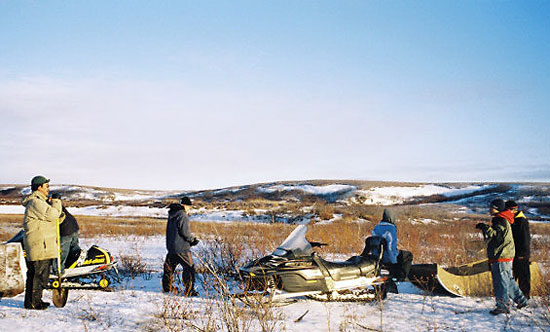
Four hours later, I got the call to go to the airstrip. I got there ready to fly, watching as the first plane comes and leaves. It's a charter and I’m on a seat fare. So I am taken back to my teacher’s house. She was inside baking cookies, but didn’t answer the door because she didn’t hear me knocking. Luckily it was not freezing outside! So the school custodian returned to take me back to the airstrip, and reassures me this is the plane. The second plane arrived and was quite big, but not going to my destination, so they left me behind. I decided to sit at the airstrip because the truck was full of volleyball players who just arrived and needed to be transported to the school.
After about 20 minutes, the third plane arrived. I politely asked if it’s going to my destination, and the pilot responds, "Yes." He put my luggage on the plane and we were off. We arrived at the correct airport in about 15 minutes . It was a great take off, flight, and landing. So I had to ask this very young gentleman how old he was, and he replied "20"—definitely my youngest pilot ever, but a very talented one.
My next few trips were no problem because I knew there was “real” transportation, in the form of trucks, vans, or even school buses. However, I had “the date” circled on my calendar. I knew that on this day and in this village, I would have to ride.
This was the first time in years that I was more nervous about the ground ride than the plane ride. We touched down (actually we skidded sideways down the runway), and when I started to deplane, I fell out onto the ground. In true village fashion, none of the folks said anything (did I mention that the whole village usually greets the plane?), except an elder who remarked, “Must be from the city.” It was then that I saw it: a shiny new pickup truck! One of the locals purchased a 4-wheel drive vehicle and was giving everyone rides, everywhere, so I hitched a ride.
The best part of the trip was the mentoring. I observed the site's early career teachers, shared some teaching strategies, and had some great conversations. However, as I curled up in my sleeping bag, on my sleeping pad, on the floor, I knew that tomorrow would come and I would get a chance to try out my new skill.
The snow machine with sled attached pulled up to the school and I could delay no longer. I made a speedy exit (or so I thought) and approached the behemoth. Just as I was about to swing my leg up and over, the driver said, “Oh look, they came to say goodbye!” I turned to find the entire school population, teachers, the custodian, someone’s grandmother and the several dogs, waving goodbye. The pressure was on. I met the driver’s eyes with mine and with a knowing nod he stood up and moved forward. My adrenalin was pumping and I was ready. In one swift motion that would have impressed Baryshnikov, I confidently swung my leg up—and over!
Unfortunately, the real story begins here. The ambient temperature was ten degrees. With the wind chill factor, I was looking (literally) at 15 below. I have a hood on my parka for these occasions but I had a choice to make: partially cover my face and brave the wind, or completely cover up and trust. As though he had read my mind, the driver said, “Better cover up!” I did.
Apparently, the driver moonlighted as a trailbreaker for the Iditarod, because if there was a road, I am still looking for it. This five-mile trip made Space Mountain feel like Mr. Toad’s Not-So-Wild Ride. Between holding my hood and holding on for dear life, I had run out of hands and was terrified—but not as terrified as the prospect of getting off the snow machine.
Several harrowing minutes later, we arrived at the landing strip (Did I mention that the whole village greets the plane). The driver knew what was coming and I could swear he was already laughing. He got off the snow machine before me, to get a better vantage point. I tried twice, unsuccessfully, to swing my leg over but the hammy wasn’t having it. After the third attempt, I lost my pride (and my balance) and fell off the machine onto the frozen tundra. The driver looked down, extended his hand and said, “Best ride ever, huh?” In my best Mentor language, I replied, “So far!”
Her principal told me how pleased he was at her progress over the year. He expressed his gratitude at having someone to work with her to facilitate and support her growth— something he didn't have the time to do. He told me that she could have been a casualty but he thought instead, thanks to the support she received, that she was turning out to be a credit to her profession.
I love mentoring. It is a joy to work with and support 18 teachers across the state. I realize that a trusting relationship with teachers is critical in advancing teachers in their practice. It is especially an honor to spend time on St. Laurence Island. The bright smiles and "Hi, Bob!" greetings I get from the children in the lunchroom, hall, and class make me realize that as a mentor I still make meaningful connections to students. I am in my second year of mentoring, and I have grown more professionally in the past year and half than at any other point in my career.
I arranged my March visits so that I would be in a “checkpoint” village as mushers were coming and going, not realizing that it would not just be mushers coming and going. I usually sleep in the school and saw no reason to change my plans, an error on my part.
I cannot describe the incredible feelings I felt as I, along with other residents and visitors, followed a team from the coastline to the outskirts of the village and finally, to the checkpoint. It was 10:00 pm, I got great pictures and decided it was time to turn in—or so I thought. The musher followed me into the school (coincidentally), along with race officials, locals, and tourists. It was just beginning to sink in that I had made a tactical error. I would have gotten more sleep if I had stayed outside with the dogs. Between the mushers planning their strategies, the tourists buzzing about the school, the race officials warming their hands and feet and the kids who loved the fact that the school was open, there was activity well into the night, and the next morning. I got no sleep.
As I reflect upon that night and morning, I do smile because I experienced the Iditarod from the trail, something that not everyone can say. However, this spring during Iditarod week, I plan to head south!


